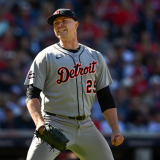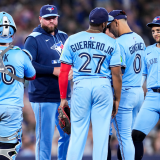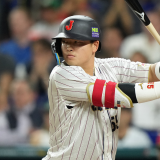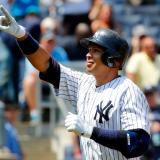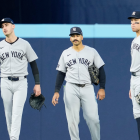Dodgers bullpen issues: How many more meltdowns can Los Angeles survive this postseason?
The defending champs are seven wins away from another World Series title, but their volatile bullpen could decide whether they repeat or unravel
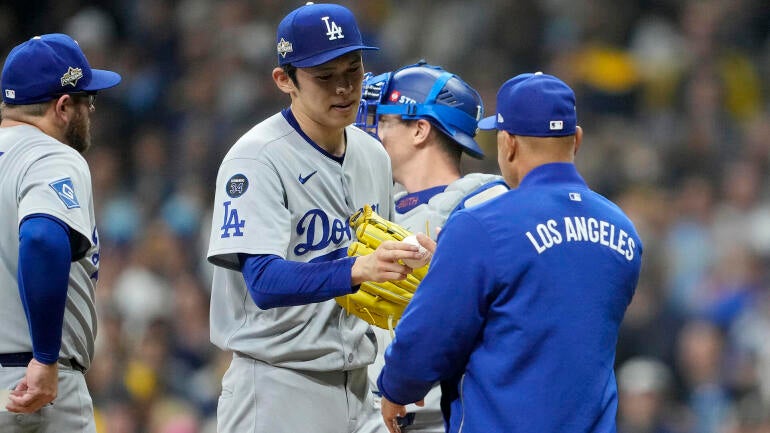
The Los Angeles Dodgers defeated the Milwaukee Brewers on Monday in Game 1 of the National League Championship Series. The Dodgers, now seven wins away from becoming Major League Baseball's first repeat World Series champions in a quarter century, have perfected a certain kind of victory. If you've watched them enough this year, you've picked up on their usual hallmarks: strong starting pitching; timely hitting and quality defense from a star-studded lineup; and an unmistakable sense of agita stemming from a bullpen that can be charitably described as volatile.
Game 1 included all of the above, culminating in an eventful ninth inning that saw relievers Roki Sasaki and Blake Treinen combine to surrender a run on a hit and three walks. Were it not for second baseman Brice Turang's reflexes, it's possible the Dodgers bullpen would have lost the game. There's a reason why I've identified Los Angeles' relief corps as an x-factor in multiple series. Few bullpens were more prone to placing themselves in detrimental situations throughout the regular season.
Just how many more times can the Dodgers watch as their relievers walk the tightrope this October before it costs them in a material way? The actual answer is: as many times as the scoreboard allows. All the same, I dug in on what history says about bullpen effectiveness and winning the World Series.
FanGraphs tracks a metric called "meltdowns" that leverages Win Probability Added to credit or debit players (or units) on how much they've aided their team's efforts. FanGraphs also tracks the inverse measure, called shutdowns, and the total number is scaled to the combined number of saves and holds. Anyway, the Dodgers bullpen was particularly poor in this measure: they tied with the New York Mets for 29th, ahead of only the Chicago White Sox. (Neither the Mets nor the White Sox made the playoffs.)
Just how often does a team reach the World Series, let alone win it, with such a sieve-like bullpen? In the table below, I've included each pennant winner of the last 10 years, plus where their bullpens ranked in this category. The lower the rank, the better, so a team ranking No. 1 had the fewest meltdowns, while a team that ranks 30th would've had the most meltdowns in the majors. I've also included a column in the table detailing how the superior bullpen fared in the Fall Classic. Take a look:
| Year | World Series winner (rank) | World Series loser (rank) | Superior bullpen … |
|---|---|---|---|
2024 | Dodgers (t-21st) | Yankees (4) | Lost |
2023 | Rangers (t-14) | D-backs (t-9) | Lost |
2022 | Astros (1) | Phillies (11) | Won |
2021 | Braves (t-17) | Astros (t-12) | Lost |
2020 | Dodgers (t-9) | Rays (t-21) | Won |
2019 | Nationals (14) | Astros (1) | Lost |
2018 | Red Sox (t-12) | Dodgers (15) | Won |
2017 | Astros (t-10) | Dodgers (2) | Lost |
2016 | Cubs (t-6) | Guardians (2) | Lost |
2015 | Royals (1) | Mets (4) | Won |
As you can see, the better bullpen -- at least judged only by meltdowns -- won on just four of the last 10 occasions. That might be a little surprising at first, especially given some of the gaps between the teams. Last year's matchup, for instance, saw a bottom-10 bullpen beat a top-5 bullpen. But I think it's easier to understand how this happens when you take some other variables into account.
Ants aren't expert pathfinders because of their instincts alone. They get the job done because they're relentless editors, consistently improving their routes to be as efficient as possible. The same is true for MLB teams when it comes to their postseason bullpens. For the most part, pitchers who were ineffective during the regular season are not going to be handed high-leverage situations in October.
There's also the matter of a greater pool of pitchers to choose from. These Dodgers, for instance, have a drastically different bullpen now than they did a month ago. Lefty Tanner Scott, himself prone to melting down, is sidelined after undergoing a medical procedure, and the Dodgers have slotted in several of their surplus starters, including Sasaki, Emmet Sheehan, and Clayton Kershaw. It stands to reason that the Dodgers are going to continue to finetune things as they proceed. If that means going full 2019 Nationals and using some of their starters on throw days, well, they might just do that.
So, is the Dodgers bullpen an area of concern? Yes, absolutely. Any late-and-close situation is going to raise the collective blood pressure of the Los Angeles area. But that doesn't mean the Dodgers are necessarily doomed in their pursuit of another World Series title. They'll just have to remain as flexible and as creative as the situation allows.


